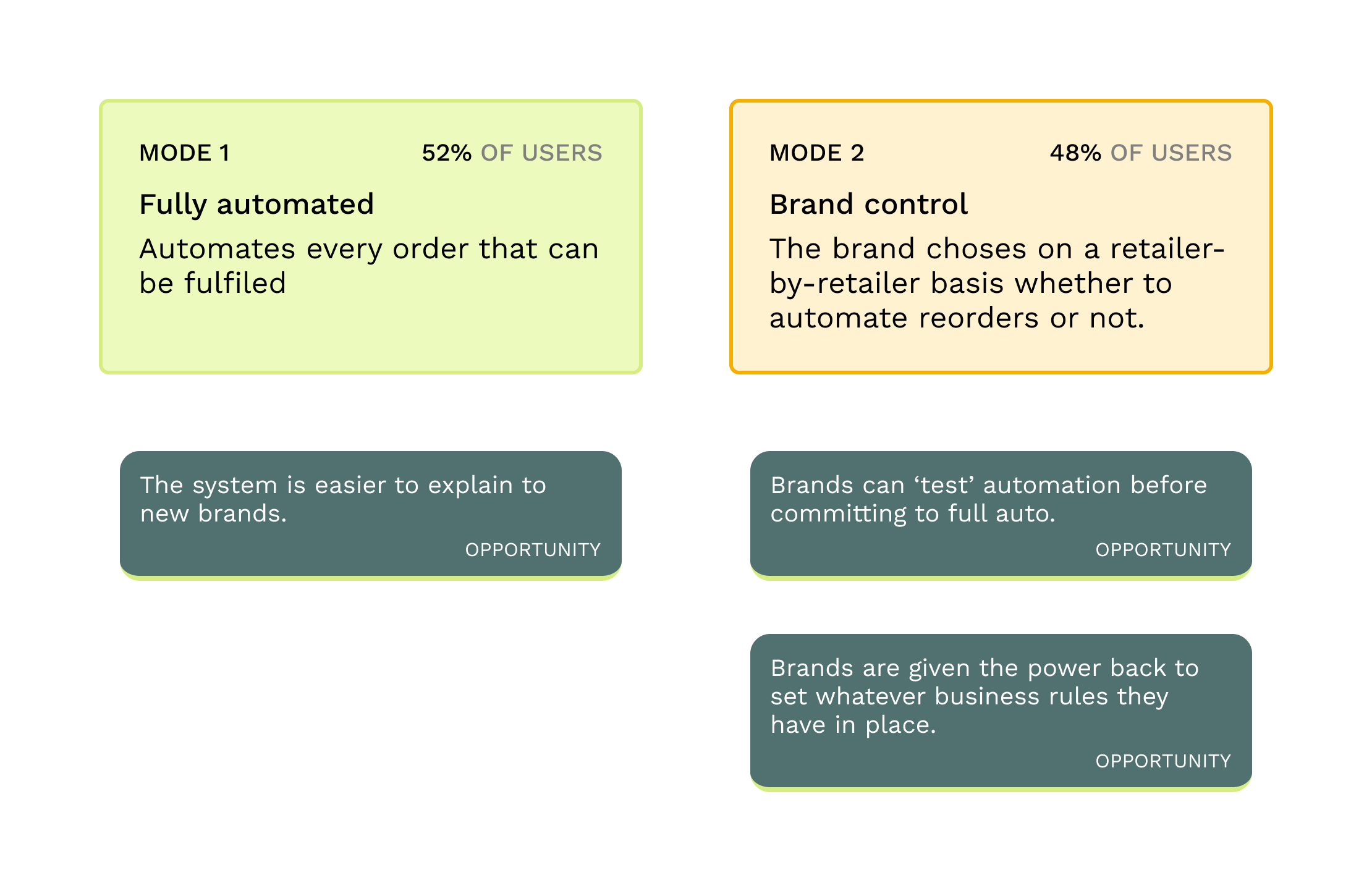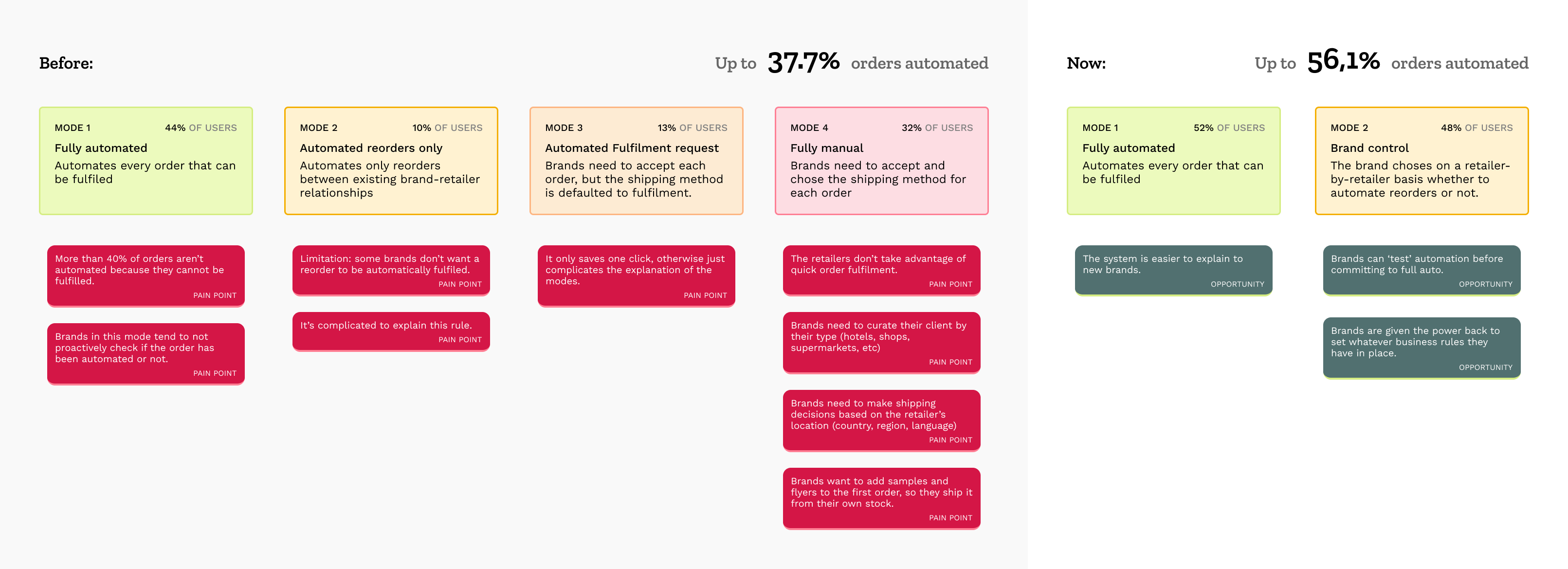Why automate?
To understand the value of automation, let's look at what happens when a brand processes orders manually on Ankorstore.
In the manual flow, when a retailer places an order, the brand receives an email. What follows is a time-consuming process, where the brand has to:
- notice the 'new order' e-mail and make time to tackle it
- log into the Ankorstore web app
- verify that the retailer meets their own curration rules
- check the availability of the ordered stock
- make a decision to: accept, reject, or modify the order
- choose a shipping method: fulfilment by Ankorstore or ship from their other stock
Problem statement
Only 44% of users adopted the automated path, while 32% preferred to have a fully manual experience. The rest chose to have a hybrid mode.
On the other hand, when a brand has stock in Ankorstore's fulfilment center, a fully automated order skips all these steps. The algorithm instantly accepts the order and signals the warehouse to begin preparation - no manual intervention needed.

An automated order is a win-win-win situation: the retailer gets their merchandise as fast as possible, the brand doesn't have to worry about logistics, and Ankorstore maximises the usage of the fulfilment service.
Why not automate?
Opting for the automated mode was strategically pitched as the best alternative by the sales team, yet they had problems convincing 56% of the users to adopt it. This became a great source of data for improving the feature.
As sales people have the great habit of logging the reasons why their clients reject an offer, I found a treasure trove of qualitative data to inform my understanding of the problem: feedback from 40 users on why they chose not to automate. This way, we identified several key barriers preventing brands from adopting full automation:
- Complex System Design
The automation system was difficult to explain during onboarding, even our own team members struggled to differentiate between the modes. - Limited Curation Control
Brands needed to maintain control over their client base. For example, an eco-conscious brand didn't want to sell to supermarket chains. The automated system didn't allow for this level of filtering. - Regional Shipping Requirements
brands have specific shipping business rules based on the destination of their client. One brand wanted to use the Ankorstore Fulfilment only to send to french-speaking countries. If an order came from Germany, they had another warehouse over there, with german packaging. - Personal Touch for New Relationships
Brands valued the ability to make the first orders to new clients special, by including product samples or personalized notes. This wasn't a service we provided at that time. - Trust Building in Early Stages
New brands were still "testing the waters" with the platform and preferred to maintain manual control until they felt more confident with the automated system.
Solution Design: Automation on Brand Terms
While the operations team suggested adding even more automation modes to address specific use cases (filtering by country, business type, etc.), I proposed a counterintuitive approach: removing and merging some of the modes.
I was inspired by the work of Leidy Klotz and the idea that innovation can also come from substraction, which we tend to systematically overlook.
So we reduced the system from four modes to just two:
- Full Automation
Same old full-auto: all orders from all retailers are automatically processed and fulfilled. - Brand Control Mode
Brands get to make the decision to autoamte on a retailer-by-retailer basis, choosing whether future orders from each retailer should be automated or handled manually.

The Implementation
We designed the automation choice to appear at a key moment in the order flow: when brands process their first order from a new retailer. After selecting a shipping method, brands are presented with a simple choice about future orders from this retailer.
The user could change their choice at any point in time.
We implemented two other key features to make the automation system more robust:
- A re-run on restock: When new stock arrives at the warehouse, the automation system automatically re-evaluates pending orders. This catches orders that were previously blocked due to stock unavailability, eliminating the need for brands to manually check and unblock them. This enhancement alone accounts for 10% of our automated orders.
- Improved Communication: Order status emails were redesigned to clearly communicate whether an order was automated or required manual intervention, giving brands better visibility into their order processing.
Impact and Unexpected Benefits
The new system was intentionally designed to build trust over time. The progression took time:
- Brand gets a new customer
- Brand chooses to automate future orders
- Results become visible when that customer places a new order
This created a virtuous cycle that proved particularly valuable during high seasons, when reorder volumes spike. Brands experienced both time savings and faster delivery times precisely when they needed it most.
Month after month, we saw steady growth in automation rates. Perhaps most surprisingly, brands choosing Full Auto mode increased from 44% to 52% — possibly motivated by wanting to avoid the automation choice pop-up 😬! This steady upward trend suggests we've created a sustainable shift in how brands approach automation.
